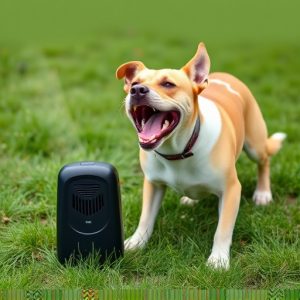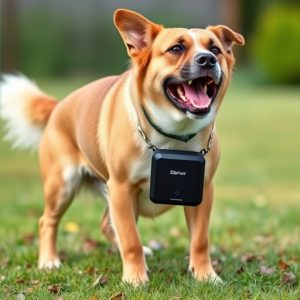Ultrasonic Bark Control: Effective Outdoor Solutions for Peaceful Neighborhoods
Excessive dog barking can disturb communities, but ultrasonic repeller devices offer a humane soluti…….
Excessive dog barking can disturb communities, but ultrasonic repeller devices offer a humane solution. Strategically placing these devices near fences or walls can deter barking without harm. They emit inaudible high-frequency sound waves dogs find irritating. The best placement ensures they're effective yet minimize disruption to humans. Regular cleaning, battery replacement, and positive reinforcement training enhance their utility.
In many neighborhoods, dog barking can be a persistent and annoying issue, straining relationships among residents. This article explores an innovative solution: anti-barking devices, specifically ultrasonic repellers. We delve into how these tools work, emphasizing their safety for dogs, and provide strategic guidance on the best placement for effective outdoor bark control. Learn about implementation tips, common issues, and maintenance to ensure a peaceful coexistence among neighbors and pets alike.
- Understanding Dog Barking and Its Impact on Neighborhoods
- How Ultrasonic Repeller Devices Work and Their Safety for Dogs
- Best Placement Strategies for Effective Bark Control in Outdoor Spaces
- Implementing and Maintaining the Device: Tips for Success and Addressing Common Issues
Understanding Dog Barking and Its Impact on Neighborhoods
Dog barking is a natural form of communication for canines, serving as a way to express emotions, alert owners of potential dangers, or assert territorial rights. However, excessive or incessant barking can be disruptive and distressing for neighbors, especially in close-knit residential areas. This behavior often arises from various factors like fear, boredom, anxiety, or protective instincts.
In such scenarios, anti-barking devices designed with ultrasonic repellers offer a humane and effective solution. The best placement for these devices is typically near the source of barking, such as fences or walls that separate individual properties. Strategically positioning them can help deter dogs from excessive barking without causing harm. These devices emit high-frequency sound waves that are inaudible to humans but disruptive to dogs, training them to associate certain environments or stimuli with the cessation of barking.
How Ultrasonic Repeller Devices Work and Their Safety for Dogs
Ultrasonic repeller devices are a popular choice among dog owners and neighbors looking to control excessive barking. These innovative tools emit high-frequency sound waves that are inaudible to humans but can be extremely irritating to dogs, effectively deterring them from barking excessively. The device’s sensitivity can be adjusted to detect specific bark patterns, ensuring it responds only when necessary. When a dog barks, the device emits an ultrasonic tone, usually ranging from 23 to 64 kHz, which is perceived as an unpleasant noise by the canine’s sensitive hearing. This method of training is considered safe because it does not cause physical harm or pain; instead, it modifies the dog’s behavior through negative reinforcement.
When placed in strategic locations, such as near windows or fences, these devices can be highly effective in managing barking without causing any lasting harm to dogs. The best placement for ultrasonic repeller devices is where they can detect and respond to bark patterns while ensuring minimal disruption to nearby humans. With proper usage and a bit of patience, dog owners can find significant relief from unwanted barking, fostering a more peaceful environment for both pets and neighbors.
Best Placement Strategies for Effective Bark Control in Outdoor Spaces
When it comes to outdoor spaces, strategic placement is key to effective bark control using ultrasonic repeller devices. These devices are most successful when positioned in areas where dogs tend to congregate or bark frequently, such as fences surrounding yards or common gathering spots in public parks. Mounting them at eye level or slightly elevated ensures maximum coverage and impact, as many barking incidents originate from visible triggers like other animals or passing people.
Consider the environment and behavior patterns of your target dogs. If they frequent certain paths or areas, place the devices along these routes. Additionally, using multiple units spread across a larger area can create a continuous barrier against barking, preventing dogs from getting accustomed to one particular device’s sound. Regular testing and adjustments in placement may also be necessary to maintain optimal results.
Implementing and Maintaining the Device: Tips for Success and Addressing Common Issues
Implementing and maintaining an anti-barking device requires a thoughtful approach to ensure its effectiveness. The best placement for ultrasonic repeller devices is usually in areas where dogs tend to bark excessively, such as close to windows or fences. Mounting them at eye level or slightly elevated ensures they are not easily disturbed by curious pets. Regular cleaning and battery replacement are crucial for optimal performance.
Addressing common issues can significantly enhance the device’s utility. For instance, ensure the ultrasonic frequency is adjustable to cater to different dog breeds. Some dogs might be desensitized to the standard setting. Additionally, proper training of both pets and owners is essential. Teach dogs alternative behaviors through positive reinforcement, while owners should learn to use the device responsibly, only activating it when necessary to avoid over-stimulation.
The ultrasonic repeller devices emerge as a humane and effective solution for managing dog barking in neighborhoods. By understanding the root causes of barking and strategically placing these devices, residents can create a peaceful environment for everyone. When used responsibly, these tools can significantly reduce unwanted noise while ensuring the well-being and safety of dogs. With proper implementation and ongoing maintenance, the best placement strategies outlined in this article will contribute to a more harmonious co-existence among neighbors, their pets, and local wildlife.


